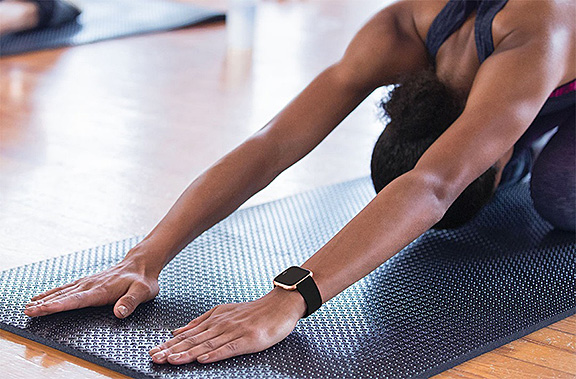Watch Your Step
How Many Steps Should You Take in a Day?
There is an undeniable sense of accomplishment when your FitBit hits 10,000 steps. Buzzing! Fireworks! You did it! You’ve reached your goal and can confidently check the day off as a successfully active one.
In recent years, the 10,000-steps-a-day regime has become ingrained in popular culture. Rarely, can you go anywhere without someone stomping past you wearing a FitBit. I’ve got one strapped to my wrist as we speak! I’m walking while proof reading this article.
Do you know how many steps you average each day? If you can rattle off the answer without even a glance at your watch, you’re not alone. Thanks in part to fitness trackers, many of us know exactly how many steps we’re clocking each day.
Regardless of the fitness wearable you purchase, 10,000 steps are likely the magical number that will be preprogrammed into your device. Why 10,000 steps? Well, when you do the math, 10,000 steps works out to approximately five miles. This 10,000 steps number came from out of nowhere. There’s no actual scientific basis for the origins of the 10,000-steps recommendation. The number was developed in the 1960s by a Japanese walking club while they were producing a step-counting device under the name “manpo-kei,” which translated to “10,000 steps meter.” They marketed the tool using the slogan “Let’s walk 10,000 steps a day.” The idea resonated with people and in subsequent years, it was adopted by the U.S. as a goal to promote good health. They had an approximate estimation of how much an average person usually walked (which is between 5,000 and 7,000 steps per day) and they just set an arbitrary target of 10,000. This was something they knew would improve activity because it was higher than what people were currently doing.
The 10,000-step goal, which works out to approximately five miles, includes about 30 minutes of daily exercise satisfying the Centers for Disease Control and Prevention’s recommendation of at least 150 minutes of moderate exercise per week. Those 150 minutes a week can be divided in many different ways. Some people aim for 30 minutes of exercise, five days a week. Others fit in 10 minutes of exercise several times a day.
Benefits of walking
Walking is a form of exercise that’s available to most people. You don’t need to pay an expensive monthly fee at a fitness center to do it and no special equipment is required.
Walking for regular activity can help reduce your risk of these common health problems:
• Heart disease
• Obesity
• Diabetes
• High blood pressure
• Depression
• Certain cancers, including breast and colon cancer
How many steps should you take a day?
A 2011 study found that healthy adults can take anywhere between approximately 4,000 and 18,000 steps a day, and that 10,000 steps a day is a reasonable target for healthy adults.
Of course, you need to take into consideration other factors such as age, fitness level, diet and what you do for a living. Our job can definitely have an impact on our average steps per day!
Recent studies and research have established these categories for healthy adults based on the steps per day they logged.
Inactive (sedentary lifestyle index): less than 5,000 steps per day
Average (somewhat active): ranges from 7,500 to 9,999 steps per day
Very active: individuals who take more than 12,500 steps per day
How many steps to improve your fitness level?
To improve your fitness level, you need to know how many steps you’re currently averaging in a day. Consider purchasing a pedometer or you can use your smart phone, as most have built-in step counters.
Then, set a goal for 500 to 1000 steps higher than your current average. Work on maintaining this slight increase for a week or two. Then make another slight increase and repeat the process until you’re averaging around 10,000 steps per day.
If your current activity level and step count are on the low end (under 5,000), you may want to start by adding 250 to 500 steps per day. The first week, focus on increasing your step count by 250 each day (or every other day).
Once this feels manageable, add 500 steps each day until you consistently hit 10,000 steps per day. You can then decide to stay at this level or keep adding steps each day to move your step count into the active category.
In Conclusion:
Are 10,000 steps a day still the golden standard? Does it really indicate that you are getting enough exercise for fitness, to reduce health risks, and to support weight loss? It can be daunting to set a pedometer goal of 10,000 steps and see yourself falling short most of the time. Don’t let the number “10,000” be held over your head! Remember, physical activity of any kind is good for you. Regardless of how many steps you take in a day, just get moving!
Staying physically active on any level is a choice. You have to “choose” to make the commitment. Nothing that’s worthwhile is ever easy. I’d be lying if I told you it wasn’t going to be a lot of hard work! It takes dedication, determination, effort and self-discipline. It also requires an obligation from you to put your health first.
The next time you go to the store park a little farther away. Walk with a friend on you lunch break. Take your dog for a walk when you get home from work. Whatever you choose to do, I encourage you —both men and women— to start moving. Every little bit counts and it will have a huge impact on your health in the long run. Good luck to you.











